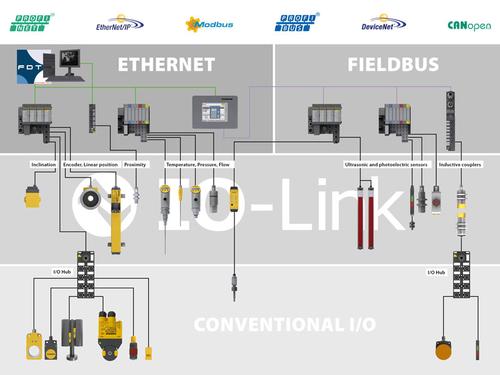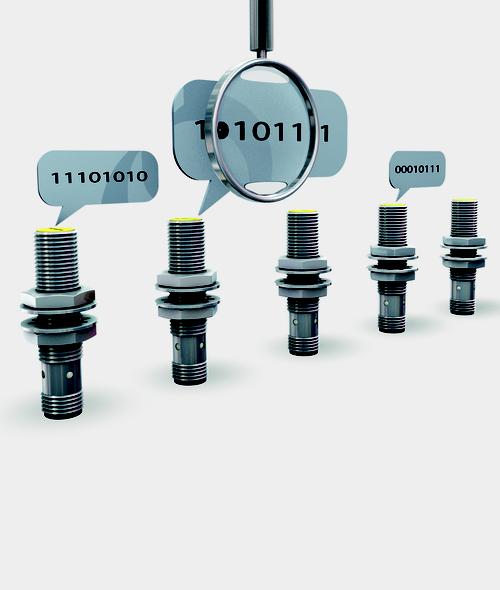How IO-Link Improves Sensor-Level Diagnostics and Communication
New sensors for the IO-Link standard are helping manufacturers reduce machine costs and downtime and simplify configuration. Here’s a look at how it helps and how it compares to previous technologies.
October 13, 2016
Sensors are a fundamental piece of an automated environment. With the continuing focus on the Industrial Internet of Things (IIoT), many engineers are exploring how IO-Link can unlock data in industrial sensors in a way that wasn’t possible before.
IO-Link is a global standard that improves communication from sensors and actuators so engineers can better understand what’s happening on the plant floor, at the sensor level.

This diagram gives a visual representation of where IO-Link enabled sensor products fit into a typical industrial system. IO-Link sensors operate at a higher level than conventional sensors to provide important data and information back-up to the upper-level system.
With this capability, manufacturers can use data and diagnostics to improve productivity and reduce downtime through parameterization. Design engineers can simplify configuration and reduce machine costs by decreasing the number of I/O connections needed in an application, and better connect their plant to take advantage of the IIoT.
IO-Link Architecture in Automated Environments
IO-Link is a certified industrial standard for sensor communication that is based on a point-to-point connection between a sensor, actuator or I/O hub, and an interface module. The technology was created by a consortium of manufacturers to improve sensor-level communication in industrial environments.
When a sensor is IO-Link capable, it can communicate more detailed information about what’s happening at the device level. At the control panel, the operator can use this data to make decisions about the system and maintenance needs.
To implement IO-Link into automated environments, the sensor, actuator or I/O hub and its master must be IO-Link capable. The master connects to a gateway, which in turn passes the signals to the PLC. Because IO-Link is fieldbus and manufacturer independent, it can be used with a variety of protocols and platforms.
IO-Link intelligence can be incorporated into virtually any sensor type, as long as the sensor has a microprocessor. This microprocessor allows end users to monitor the sensors and gather diagnostic information.
How IO-Link Advances Operations on the Plant Floor
Before IO-Link, communication from sensors was limited. For example, linear and rotary sensors could not communicate if a position element was in or out of range. Similarly, a temperature sensor without IO-Link may only be able to communicate if it’s inside its optimal operating range.
With IO-Link, sensors can communicate more than just the basics. They can communicate about health, safety, and environmental factors, such as specific temperature, placement of a position element, or if a pressure rating has been exceeded.
Linear and rotary sensors are now able to communicate how out of range a position element may be. An engineer can read the ambient temperature and plan for preventative maintenance when temperatures are trending too high or too low for best performance. This level of detail and diagnostics helps direct maintenance and service activities.
3 Reasons Why OEMs and Manufacturers Choose IO-Link
IO-Link can benefit nearly all industrial automation environments where there is interest in learning more about what’s happening at the sensor level. This is especially helpful for companies looking to adopt IIoT practices. Sensor parameterization and validation, improved data and diagnostics, and reduced machine costs are three leading reasons why OEMs and manufacturers choose to implement IO-Link systems.
Sensor parameterization and validation. IO-Link can be used to set sensor parameters, so when a sensor is replaced its required parameters can simply be downloaded to the new sensor. Application tags can also be added to identify individual sensors, which helps pinpoint location in a system.

Using an “application-specific tag," each Uprox3 IO-Link sensor from Turck can be individually identified.
Sensor validation is another key advantage. When an IO-Link sensor is used in an IO-Link system, the system sends confirmation to the user that the replaced sensor is the right sensor for that critical application.
It will also communicate if the wrong sensor has been used. This has practical benefits on the plant floor, as many manufacturers’ sensors look very similar. Pressure sensors are just one example. In an IO-Link system, an engineer has immediate feedback on startup if a 10-bar sensor was used instead of the 100-bar sensor required by the application. When application tags are applied, the operator can easily target where the error is, for quick resolution.
Improved data and diagnostics. IO-Link allows engineers to access in-depth data about sensors and systems so they can see the information that’s most important to them. The data lets them quickly diagnose if something unusual happens and then schedule preventative maintenance if needed.
This can be seen in linear and rotary sensors. With IO-Link, if a target is getting too far from the face of the sensor, the engineer can set parameters to show an alarm that says the signal is weak. Grounded in data, this warning may signal that an element is wearing or about to lose contact with the sensor, and maintenance can be scheduled before the signal is lost entirely.
Reduced machine costs. Industrial automation machine costs can increase depending on the number of I/O points. IO-Link technology allows engineers to make the most of each connection point by creating high-density I/O.
 IoT Thinks Outside the Box. The Internet of Things is a vast system of devices that must communicate reliably and efficiently. In the IoT track, learn about sensor fusion, big/small data, communications protocols and wearable systems design. Only at ARM TechCon. Oct. 25-27, 2016 in Santa Clara, CA. Register here for the event, hosted by Design News’ parent company UBM.
IoT Thinks Outside the Box. The Internet of Things is a vast system of devices that must communicate reliably and efficiently. In the IoT track, learn about sensor fusion, big/small data, communications protocols and wearable systems design. Only at ARM TechCon. Oct. 25-27, 2016 in Santa Clara, CA. Register here for the event, hosted by Design News’ parent company UBM.
In high-density I/O systems, multiple sensors are linked to hubs. Multiple hubs can connect to one gateway that links to the PLC. By increasing the number of connections to one gateway and decreasing the number of gateways that connect to a PLC, manufacturers can save on device costs and cabling material. The home run cable from an IO-Link hub uses only three wires as compared to traditional junction boxes that have as many as 19 conductors that need to be properly wired into an input on a PLC.
Another machine cost savings is in the connectivity itself. IO-Link signals are digital and can be reliably communicated via standard M12, 3-wire cordsets, which are less expensive than analog counterparts. In typical analog systems, more robust cabling with twisted, shielded pairs is needed to prevent electrical noise from corrupting the signal.
Since IO-Link entered the market in 2007, this technology has improved manufacturers’ ability to see what’s happening at the sensor level, while also saving on machine costs. With the ongoing focus on the Industrial Internet of Things, this technology will continue to open critical data pathways in the effort to better understand industrial environments.
Tony Udelhoven is the vice president of Turck's Sensor Division, which makes sensors for the industrial market.
READ MORE ABOUT SENSORS ON DESIGN NEWS:
You May Also Like

.jpg?width=300&auto=webp&quality=80&disable=upscale)

